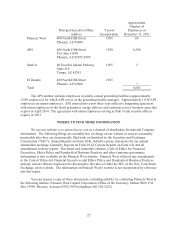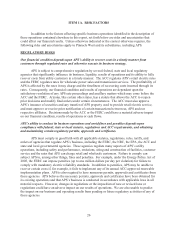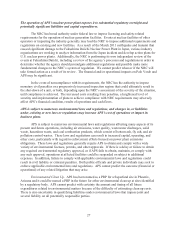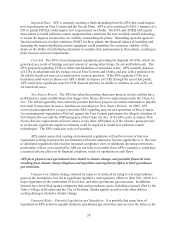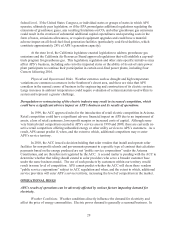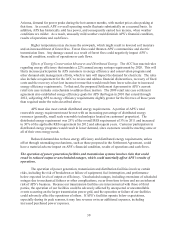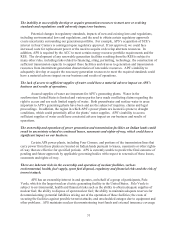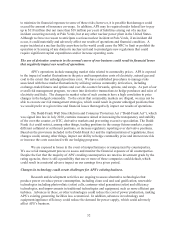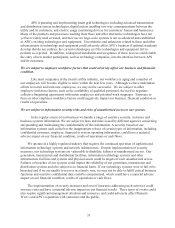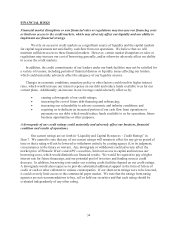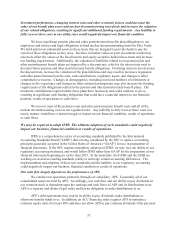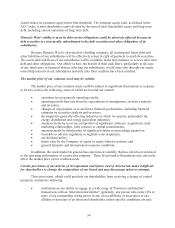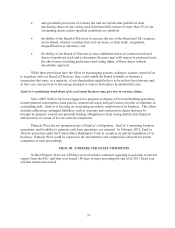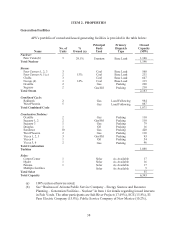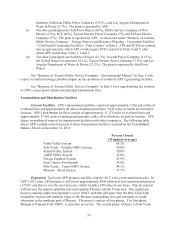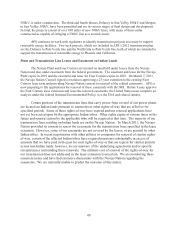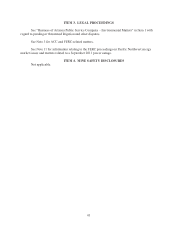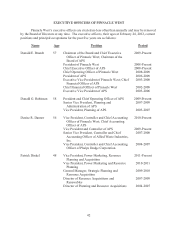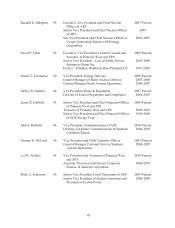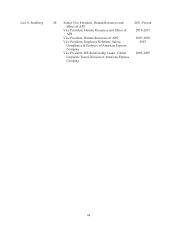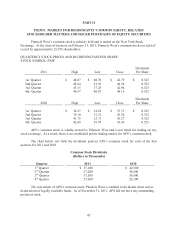APS 2011 Annual Report Download - page 59
Download and view the complete annual report
Please find page 59 of the 2011 APS annual report below. You can navigate through the pages in the report by either clicking on the pages listed below, or by using the keyword search tool below to find specific information within the annual report.35
Investment performance, changing interest rates and other economic factors could decrease the
value of our benefit plan assets and nuclear decommissioning trust funds and increase the valuation
of our related obligations, resulting in significant additional funding requirements. Any inability to
fully recover these costs in our utility rates would negatively impact our financial condition.
We have significant pension plan and other postretirement benefits plan obligations to our
employees and retirees and legal obligations to fund nuclear decommissioning trusts for Palo Verde.
We hold and invest substantial assets in these trusts that are designed to provide funds to pay for
certain of these obligations as they arise. Declines in market values or poor investment results may
adversely affect the values of the fixed income and equity securities held in these trusts and increase
our funding requirements. Additionally, the valuation of liabilities related to our pension plan and
other postretirement benefit plans are impacted by a discount rate, which is the interest rate used to
discount future pension and other postretirement benefit obligations. Declining interest rates decrease
the discount rate, increase the valuation of the plan liabilities and may result in increases in pension
and other postretirement benefit costs, cash contributions, regulatory assets, and charges to other
comprehensive income. Changes in demographics, including increased numbers of retirements or
changes in life expectancy and changes in other actuarial assumptions, may also increase the funding
requirements of the obligations related to the pension and other postretirement benefit plans. The
minimum contributions required under these plans have increased, and could continue to do so,
resulting in significant cash funding obligations that could have a material impact on our financial
position, results of operations or cash flows.
We recover most of the pension costs and other postretirement benefit costs and all of the
nuclear decommissioning costs in our regulated rates. Any inability to fully recover these costs in a
timely manner would have a material negative impact on our financial condition, results of operations
or cash flows.
We may be required to adopt IFRS. The ultimate adoption of such standards could negatively
impact our business, financial condition or results of operations.
IFRS is a comprehensive series of accounting standards published by the International
Accounting Standards Board (“IASB”) that is being considered by the SEC to replace accounting
principles generally accepted in the United States of America (“GAAP”) for use in preparation of
financial statements. If the SEC requires mandatory adoption of IFRS, we may lose our ability to use
regulatory accounting treatment, and would follow IFRS rather than GAAP for the preparation of our
financial statements beginning no earlier than 2015. In the meantime, the FASB and the IASB are
working on several accounting standards jointly to converge certain accounting differences. The
implementation and adoption of these new standards and the inability to use regulatory accounting
could negatively impact our business, financial condition or results of operations.
Our cash flow largely depends on the performance of APS.
We conduct our operations primarily through our subsidiary, APS. Essentially all of our
consolidated assets are held by APS. Accordingly, our cash flow and our ability to pay dividends on
our common stock is dependent upon the earnings and cash flows of APS and its distributions to us.
APS is a separate and distinct legal entity and has no obligation to make distributions to us.
APS’s debt agreements may restrict its ability to pay dividends, make distributions or
otherwise transfer funds to us. In addition, an ACC financing order requires APS to maintain a
common equity ratio of at least 40% and does not allow APS to pay common dividends if the payment


